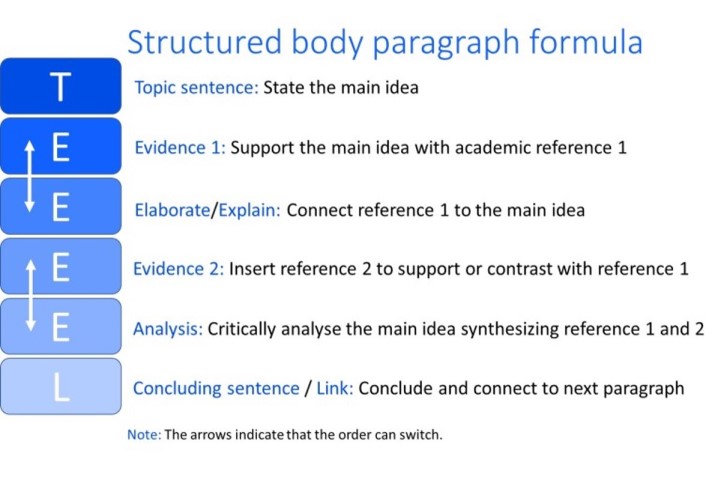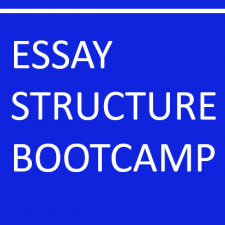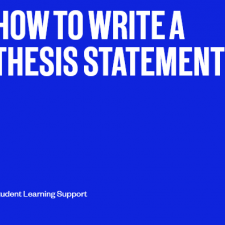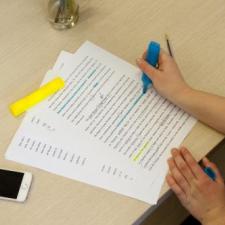Assignment Types
Essay
Content
The content of an essay is based around research of the topic. This means explaining and justifying your ideas based on information and examples from reliable sources. It is important that your essay has a central idea or argument that the essay content is focussed on. This is known as a thesis statement.
Depending on the essay question, the essay may contain:
- a thesis statement (claim, proposition, main idea)
- context (background, framework, setting)
- reasons (support, evidence, examples)
- counter-arguments (objections, contrary considerations)
- responses (refutations, answers to objections)
Structure
Usually, an essay has four main components: an introduction, a series of body paragraphs, a conclusion, and a reference list.
Introduction
The introduction consists of:
- a general statement (usually called a 'topic sentence') about the topic/issue under discussion
- background information on the topic/issue
- definitions of key terms (if applicable)*
- an outline of the main structure of the essay (usually called 'signposting'). This can be drawn from the content area/s you need to address
- a thesis statement that introduces the argument/s you will be making in your essay
A thesis statement is a sentence usually found at the end of an introduction, which sums up the central point of your paper. It should answer the question or respond to the task set out in the assessment instructions. It is a clear and concise statement that describes the scope, purpose and direction of your paper. The thesis statement serves as a preview of the position you will take in the paper. The main point in each body paragraph should relate back to this statement.
* Any terminology, jargon words, or words that relate to the essay topic should be defined using relevant theory (and should be referenced correctly). Any key terms you use should come from journal articles, books, and other reliable sources. Note that general dictionary definitions usually do not have the same word meaning/s as those used in your specialised area/s of study.
Generally, an introduction is approximately 5%-10% of your actual word count.
Body Paragraphs
The body of your essay expands on your arguments/thesis statement. In each body paragraph, you present relevant information and research that supports your arguments/thesis statement. It is important that the information is organised into clear paragraphs with a logical order. When writing your body paragraphs you should aim to guide the reader through your reasoning process and offer a clear explanation of each point you make so that you develop your argument effectively. Each paragraph should explore just one main idea. Body paragraphs have the following structure:
- a topic sentence identifying what the paragraph will be about (usually developing from a previous paragraph's linking sentence)
- a series of supporting sentences that develop the topic of the paragraph, and include explanations, examples, details, research, quotations, and references
- a linking sentence (sometimes called a concluding sentence) that identifes what the main topic of the paragraph was, and links to the next paragraph (note that the last body paragraphs in an essay usually does not have a linking sentence)
Avoid using paragraphs consisting of only one or two sentences, or that are longer than one double-spaced page.
Below is the TEEL formula for body paragraphs:

Conclusion
In the conclusion you need to summarise the main points and ideas that you presented in your essay. You should draw conclusions from what you have discussed and include a restatement (paraphrased) of your thesis statement (from the introduction). There should be no new material included in the conclusion; new material needs to be placed in your body paragraphs. You should not repeat the assessment requirements or the marking criteria in your conclusion.
Generally, a conclusion is approximately 5%-10% of your actual word count.
Style
Essays should incorporate plenty of linking words/phrases and signposts, which make your essay easy for the reader to follow. These words/phrases help by making the connections between sentences and paragraphs clear and indicate the flow of your ideas. They also signal to the reader how to approach the information that follows. For example:
- Use words like similarly, also and in addition to indicate that you are adding a similar idea to one already presented
- Use words like in contrast, however, and on the other hand to make a contrast or add an opposite idea to one alreay presented
- Use words like therefore, consequently and as a result to show an outcome from one of the ideas presented
- Use words like for example and for instance to give an example that further develops an idea you have presented
Linking words are very useful in creating cohesion and 'flow' in your writing. Without them, your assignment will read like a series of sentences that do not flow or present a logical argument.










